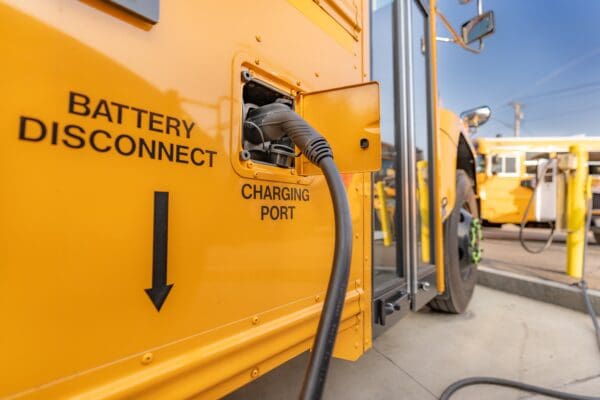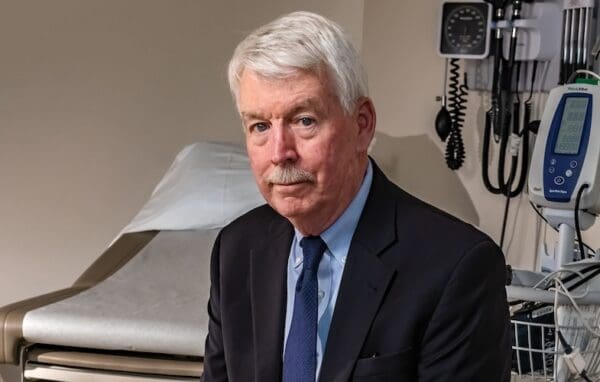
Electric buses are powering a cleaner, safer future, proving that smart investments in electric buses benefit everyone. Photo: Shutterstock.
Buses keep our towns and cities moving, whether you’re heading to a game in Boston, school in Burlington, or a doctor’s appointment in Portland. They connect us to opportunities while easing traffic and reducing toxic pollution.
But too many buses on our streets fall short on that promise. Some are loud, outdated, and spew harmful pollution. Step too close to the curb, and you’ll feel it: a blast of hot exhaust and the acrid smell of burning fuel. Inside, the ride isn’t much better – bumpy, noisy, and sometimes filled with lingering fumes.
The good news? We don’t have to settle for that. The truth is electric buses can give us the best of both worlds – the benefits of public transit without dirty fossil fuels.
Cities that have made the switch are already reaping the rewards. But despite the clear benefits, recent federal rollbacks could threaten progress, making it harder for communities to transition to cleaner transit options. It’s now more crucial than ever for our state and local officials to step up and prioritize clean transit options.
The Benefits of Electric Buses: Cleaner, Safer, and Better for Our Communities
Cleaner Air, Healthier Communities
Switching to electric buses means fresher air at bus stops, along busy streets, and in the neighborhoods that need it most. Buses that run on fossil fuels pump out toxic emissions that worsen asthma, heart disease, and lung conditions – especially for people living near major transit corridors like Route 128 in Massachusetts or I-93 across New England.
Electric buses change that equation. With zero tailpipe emissions, they help reduce asthma attacks and hospital visits. They make daily commutes healthier – not just for riders, but for pedestrians, cyclists, and families who live along those routes, too.
Quieter Streets, Safer Cities
Ever stood next to a diesel bus and felt the ground shake from the engine noise? Electric buses glide by with a soft hum. Inside, rides are much smoother – no rattling seats, no vibrations (at least not from the bus, even we can’t control potholes).
That silence isn’t just a luxury – it makes cities safer. Quieter streets allow us to hear traffic, conversations, and alerts more clearly. Less noise pollution also means lower stress levels and better sleep for those living near busy routes.
Keeping Kids Safe on Their Way to School
More than 25 million children take school buses to class every day – many of them sitting just feet away from diesel exhaust. Studies show that breathing in these fumes can harm lung development and affect a child’s ability to concentrate in school.
Electric school buses eliminate toxic emissions, making school drop-offs and pick-ups healthier for kids, teachers, and parents. Cities across the country are already making the switch – because the choice is clear when it comes to children’s health.
Better at Protecting Us from Extreme Weather
New England’s winters can be harsh, and summers bring intense heat waves. Diesel buses struggle in extreme temperatures – engines stall in the cold, and overheating leads to breakdowns in the summer. Electric buses are built to handle both extremes. Their advanced battery and cooling systems make them more reliable in freezing cold and sweltering heat, ensuring riders can depend on transit no matter the season.
Electric Buses Are Already Rolling Out
The transition to electric buses is happening right now.
In Lancaster, California, the Antelope Valley Transit Authority became the first agency in the country to switch its entire fleet to electric. Its 85 battery-electric buses cut fuel costs and slash emissions, proving that full electrification is not just possible, it’s happening.
Closer to home, Boston Public Schools recently committed to adding 125 new electric school buses through a $35 million grant from the EPA. If honored, the grant would help the city meet its goal of fully electrifying all public school buses by 2030. Rhode Island’s statewide transit system is rolling out electric buses, and Massachusetts’ MBTA is adding electric models to its fleet.
Cities like Hartford, Connecticut, and multiple school districts across New England have secured funding for their first electric buses. The momentum is building – but not fast enough.
The Roadblocks: What’s Holding Us Back?
Cities, towns, and transit agencies want to continue the switch, but they face logistical challenges that must be addressed.
Mechanics know diesel, natural gas, and propane buses inside and out, from oil changes to engine quirks. They’ve spent decades diagnosing issues. Electric buses require a different skill set. Their drivetrains, battery systems, and software require different expertise. This is also true for other challenges of electric buses, like infrastructure. Charging stations must be built at depots and key locations, and midday charging requires careful route planning.
And just as we once adapted to the challenges of vehicles powered by fossil fuels, we can do the same for electric ones.
When cars first arrived in New England, they navigated cobblestone streets built for horse-drawn carriages. Gas stations weren’t located every other mile. Our communities had to adapt. Today, we face a similar transition with electric buses. Our towns and cities need the right infrastructure to support this transition – and with investments in charging stations, mechanic training, and fleet expansion, we can make it happen soon.
Funding and grants for electric buses present another big challenge.
Where Will the Money for Electric Buses Come From?
Despite the clear benefits, the transition to electric buses faces hurdles – some of them made worse by recent federal actions. While cities and transit agencies want to electrify their fleets, funding remains a major challenge.
The Inflation Reduction Act, a landmark law for clean energy, provided incentives to electric vehicle manufacturers and transit agencies looking to switch to electric buses. But recent federal rollbacks put those incentives at risk, making it harder for agencies to afford new buses and build the necessary charging infrastructure. Additionally, the Trump administration could reverse or claw back funding already committed, forcing transit agencies to delay or scale back their electrification plans.
Are Electric Buses Worth the Price Tag?
It’s true – electric buses cost more upfront. But they save our communities money in multiple ways in the long run.
For starters, electric buses require less maintenance (no oil changes, fewer moving parts, and lower risks of breakdowns). And as clean energy costs continue to drop, they’ll get cheaper to operate. That means more reliable service for riders and lower costs for cities over time.
And, while we can’t put a price tag on the well-being of our communities, research shows the impact of electric buses is measurable. Cleaner air means fewer asthma attacks, healthier families, and stronger communities – and according to Harvard T.H. Chan School of Public Health, replacing a single diesel school bus with an electric one can yield up to $247,600 in health and environmental benefits, including lower rates of childhood asthma and reduced mortality. Investing in electric buses isn’t just about saving money – it’s about making our cities and towns better places to live.
What Needs to Happen Next
Electric buses work – but for them to truly take over, we need to invest in infrastructure, training, and planning. With uncertainty at the federal level, state and local governments must take the lead.
Here’s what our leaders must prioritize:
- Expand charging infrastructure so buses can recharge overnight and on the go.
- Fund training programs for mechanics and operators so agencies can maintain reliable service.
- Help agencies plan for fleet expansion to have enough buses to meet demand.
- Start the transition in the neighborhoods fighting the worst pollution from diesel exhaust now.
We already have the technology. Now, we need the commitment to use it.
Take Action: Help Bring More Electric Buses to Your City
Want to see more electric buses in your community? Call on your state and local leaders to invest in charging stations, workforce training, and fleet expansion. Every new electric bus makes a difference. Let’s get more of them on the road – and fewer diesel fumes in our streets.



